Secrets for sinful prose
“One pearl is better than a whole necklace of potatoes,” the French mime Étienne Decroux used to remind his students. His dictum works equally well for students of writing. Each word we choose is—or should be—a gem.
Whether you’re a floodgates-open writer or a blocked writer, remember: The first draft is for just getting the ideas down. It’s in the revising that we sift through our words, letting only the most perfect specimens adorn the thread of syntax. These “seven secrets of sinfully good prose” will help you banish the potatoes and burnish the pearls.
Secret #1: Use specific, concrete nouns and adjectives.
Well-chosen nouns and adjectives are critical in setting scenes, establishing character, and giving readers strong visual images. The best nouns are not just concrete (naming something that can be seen, touched, heard, tasted, or felt), but also highly specific. Search for the most evocative and exact. Why choose “house” when the options include cottage, Victorian, duplex, dacha, shack, bungalow, and bachelor’s pad? (Please, stay away from abstractions like abode, dwelling, domicile, or residence.)Watch for clusters of abstract nouns. When a school principal wrote to parents urging a “communication facilitation skills development intervention” he should have tried harder to be clear: “We all need to help students write better.” Cross out groups of polysyllabic, abstract nouns and start over with one or two simple, clear words.
Strong nouns help you cut adjectives. Novice writers make the mistake of gooing up their descriptions with a lot of lush adjectives. Resist. Make every adjective count. Why use “yellow” given the options: bamboo, butter, jonquil , lemon, mimosa, saffron, and sauterne? The writer Diane Ackerman, in an article on golden lion tamarins, described the yellowish monkey as a “sunset-and-corn-silk-colored creature” with “sweet-potato-colored” legs, a “reddish” beard, and a chest and belly “the tawny gold of an autumn cornfield.” Now that’s exact!
Adjectives can do double-duty, painting both physical and psychological detail. In a profile about a North Carolina revenue agent, Alec Wilkinson wrote that Garland Bunting has “eyes that are clear and close-set and steel blue.” Those three adjectives convey Bunting’s glare and capture his gritty personality.
Secret #2: Pick action-packed verbs.
All verbs are either Static (to be, to seem, to become) or Dynamic (to whistle, to waffle, to wonder). The Static verbs are the ones that pour out naturally when we write or speak—“is” appears endlessly in most first drafts. But Dynamic verbs give writing power and drama. Rephrase sentences with Static verbs to fill them with action. And not just any action: To describe someone walking down the street, consider gambol, shamble, lumber, lurch, sway, swagger, and sashay.Roger Angell packs his description of a baseball catcher with powerhouse verbs:
“He whacks his cap against his leg, producing a puff of dust, and settles it in place, its bill astern, with an oddly feminine gesture and then, reversing the movement, pulls on the mask and firms it with a soldierly downward tug. The hand dips between his thighs, semaphoring a plan….”
Angell notes all the little movements as well as the grand ones, and in his searches for the right verb, drafts nouns if necessary (a semaphore is a hand-held signal flag).
Secret #3: Avoid adverbs.
If you pick pointed verbs, you’ll be able to forgo adverbs. Many adverbs merely prop up a ho-hum verb. Strike “speaks softly” and insert murmurs. Erase “eats quickly” in favor of hoovers.Many adverbs are hauled in just to add emphasis—very, definitely, really, quite. But, oddly enough, in writing these actually subtract power. In lieu of “very pretty,” write fetching. Forget “extremely good”; favor delicious. Rather than “really nervous,” go with trembling.
Secret #4: Pare prepositional pileups.
Prepositions—words like on, of, above, beyond, near and next to—are little words that act like connective tissue in sentences. If we say “Let’s go to the store on the corner of my street,” we’ve used two prepositional phrases: “on the corner” tells us which store, and “of my street” tells us which corner. But isn’t it cleaner just to say “the corner store?”Prepositional pileups can be distracting. Clear the clutter! Convert prepositional phrases into single words:
- now, not “at this point in time” or “in this day and age”
- for instead of “in the interest of”
- neat rather not than “neat in appearance”
- to believe is better than “to be of the opinion that”
- to consider over “take into consideration.”
Secret #5: Keep track of your subjects, and keep your parts parallel.
After picking the pearls, focus on how to string them onto the filament of the sentence. Start by tracking your subjects and verbs. After you’ve reviewed the verbs, making sure that they are dynamic and specific, do a subject check. Can you identify the person or thing that is performing the action? By controlling the subjects of individual sentences we control the focus of the entire piece.The more you eliminate noun clutter, excessive adjectives, adverbs, and prepositional pileups, the closer your sentences will hew to these four basic sentence patterns:
Subject + Dynamic Verb
Subject + Dynamic Verb + Direct Object
Subject + Dynamic Verb + Indirect Object + Direct Object
Subject + Static Verb + Complement
Don’t be afraid to keep your sentences stark. This lead from a newspaper story on California's tofu industry sticks to simple sentences, and accomplishes both clarity and comedy: “It’s white. It’s weird. It wiggles on a plate.” The writer keeps tofu as her subject and resists the urge to insert herself (“I’ve always thought tofu…”). Then she follows each subject immediately with a verb (is/is/wiggles).
Muhammed Ali was a master of the powerful punch, whether physical or verbal. This rap from 1974 shows he can keep sentence parts parallel: “Only last week, I murdered a rock, injured a stone, hospitalized a brick. I’m so mean, I make medicine sick.” Ali keeps his subject steady and repeats the same construction as often as he does his jabs.
Secret #6: Play with voice, sound, rhythm.
Ali also plays with musicality, with unexpected rhyme of “brick” and sick.” Begin to experiment with elements like rhyme, alliteration, and onomatopoeia. Alliteration repeats the initial sounds in words: sin and syntax, content of their character, Walter Winchell wannabe. Onomatopoeia allows the sound of a word to echo the sound of the thing: dishes crash, teeth gnash, and Saran Wrap crinkles.Play also with rhythm. Choose short, single syllable words to set up a staccato rhythm (Churchill’s bracing “I have nothing to offer but blood, toil, tears, and sweat”), or more mellifluous words for a more melodious flow (Lincoln’s “Four score and seven years ago, our fathers brought forth on this continent a new nation, conceived in liberty, and dedicated to the proposition that all men are created equal.”). Vary the rhythm of sentences: Write a passage in short, crisp sentences. Write it again letting phrases elongate. Mix long and short, noting how short sentences pack a punch and how longer ones soften your message.
Playing with sound and rhythm is one way to develop your voice as a writer. Play with other elements, too—long sentences and short ones, the first person and the second, glorious words and guttural ones.
Secret #7: Make metaphors.
Metaphor, the comparison of disparate things, adds surprise, freshness, and depth. Don’t just repeat an old cliché (“tension so thick you could cut it with a knife”). Metaphors must be invented by the writer for the particular occasion. Theodore Roosevelt accused William McKinley of having “all the backbone of a chocolate éclair.” Novelist James Salter used “the silence of a folded flag” to describe the quiet of an afternoon in provincial France.And, of course, Étienne Decroux was making a metaphor when he declared that, “One pearl is better than a whole necklace of potatoes.”
—Constance Hale
| |
Share This:





